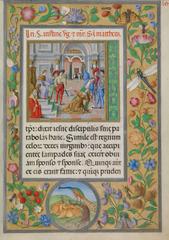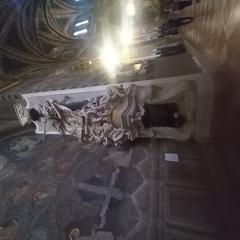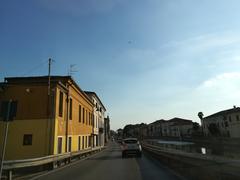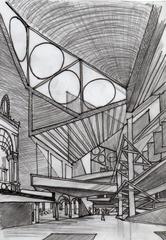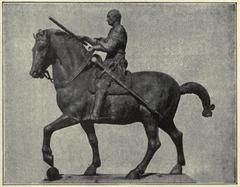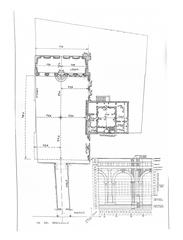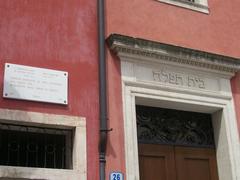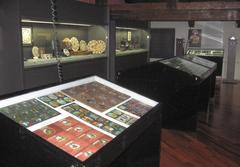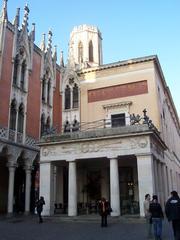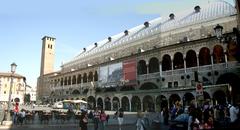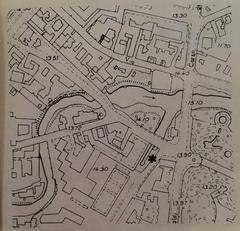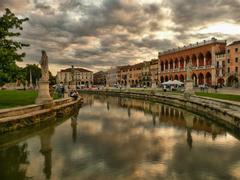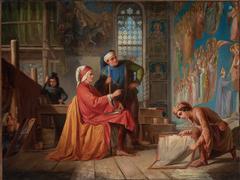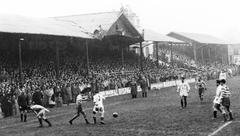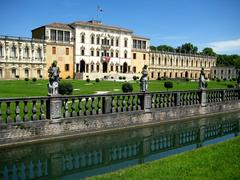
University Library of Padua: Visiting Hours, Tickets, and Guide to Padua’s Historical Sites
Date: 04/07/2025
Introduction
The University Library of Padua (Biblioteca Universitaria di Padova) is a pillar of European academic heritage, reflecting over eight centuries of intellectual pursuit and scholarly freedom. Located at the heart of one of the world’s oldest universities—founded in 1222—the library system is renowned not only for its vast collections of rare manuscripts and foundational scientific texts but also for its architectural splendor, including Renaissance courtyards and the world’s first permanent anatomical theatre. The library’s historical significance is intertwined with influential figures such as Galileo Galilei and Elena Lucrezia Cornaro Piscopia, making it a must-visit for scholars, students, and cultural travelers alike. This guide provides detailed information on visiting hours, tickets, guided tours, accessibility, and travel tips to help you make the most of your visit to one of Italy’s premier historical and academic sites.
For official updates and planning resources, see:
- [University Library System](#university-library-system)
- [Palazzo Bo Tours](#palazzo-bo-tours)
- [University of Padua History](#university-of-padua-history)
Contents
- Introduction
- Historical Development
- Architectural and Cultural Significance
- Collections and Treasures
- Academic Impact
- Visiting Information: Hours, Tickets, and Tours
- Accessibility
- Getting There
- Nearby Attractions
- Visitor Tips
- Digital Resources
- Frequently Asked Questions
- Practical Recommendations
- Contact Information
- Conclusion
Historical Development
The University Library of Padua’s origins are inseparable from the University of Padua, established in 1222 as one of Europe’s oldest centers of higher learning (University of Padua History). The earliest university libraries grew from personal collections of professors and students, scattered across various faculties. The need for a unified and accessible repository led to the formal establishment of the University Library in 1629 by the Venetian Republic (800anniunipd.it). The library’s early years saw it housed within the Jesuit monastery in the Pontecorvo district, later moving to the Sala dei Giganti (“Hall of Giants”) in 1631.
Significant growth occurred with acquisitions of private libraries from renowned scholars like Bartolomeo Selvatico, Bartolomeo Sovero, Giacomo Zabarella, and, notably, the substantial contributions from Giambattista Morgagni and Antonio Vallisneri in the 18th century. French and Austrian rule in the late 18th and early 19th centuries led to the centralization of the university’s archives, laying the groundwork for the modern library system (Historical Archive).
Architectural and Cultural Significance
The University Library is not a single building but a network of central, faculty, and preservation libraries, many located in the historic Palazzo Bo. This architectural gem is recognized for its Renaissance courtyards, the world’s pioneering anatomical theatre (built in 1594), and grand ceremonial spaces (Palazzo Bo Tours). The library’s interiors feature exquisite furnishings, such as shelves crafted by Flemish carpenter Michele Bertens in the late 17th century, now relocated to Palazzo Bo and the School of Law.
The library’s architectural features and cultural atmosphere reflect the university’s enduring motto: Universa Universis Patavina Libertas—“Paduan Freedom is Universal for Everyone” (heritage.unipd.it). This tradition of academic liberty helped attract luminaries and fostered a culture of open inquiry that shaped European intellectual history.
Collections and Treasures
The University Library of Padua holds one of Italy’s most significant bibliographic and archival heritages:
- Ancient Archive: Documents up to 1806, offering insights into medieval and early modern academic life (Historical Archive).
- Modern Archive: Records from the 19th century onward, documenting the university’s evolution.
- Special Collections: Rare books, incunabula, illuminated manuscripts, and scientific instruments—many available for research or public viewing. Digitization efforts have made portions accessible online (Digital Library).
- Faculty Libraries: Specialized collections in medicine, law, philosophy, mathematics, and natural sciences (List of Libraries).
Notable treasures include:
- The “De civitate Dei” manuscript by St. Augustine with a couplet penned by Petrarch (800anniunipd.it).
- Shakespeare’s First Folio (1623) (800anniunipd.it).
- The Digestum Vetus, a medieval legal codex representing the intersection of art and law (Digestum Vetus Article).
- Foundational scientific works by Galileo and Vesalius.
- The archives of Padua’s Botanical Garden, a UNESCO World Heritage Site (Botanical Garden).
Academic Impact
The University Library has been at the forefront of scientific and humanistic advancement since its inception. It was central to the Renaissance and Enlightenment, supporting research by figures like Galileo Galilei, Andreas Vesalius, and William Harvey (University of Padua History). The library’s collections document breakthroughs in medicine, astronomy, philosophy, and law, and continue to serve as a vital resource for contemporary scholars.
Visiting Information: Hours, Tickets, and Tours
General Opening Hours
- Most libraries are open Tuesday to Saturday, 9:00 AM to 6:00 PM; closed Sundays, Mondays, and public holidays.
- Central library sites may observe a lunch closure (1:00 PM–3:30 PM).
- Some special collections or archives require an appointment.
- Always check the official hours before your visit.
Tickets and Reservations
- General admission is free for standard collections and public spaces.
- Access to special exhibitions, the anatomical theatre, or guided tours generally requires a ticket (€5–€10).
- Tickets can be purchased online or at the entrance; advance booking is advised during peak seasons.
Integrated Ticket:
The ‘Padua City of Science’ ticket (€25 in 2025) provides entry to the library, Botanical Garden, Museum of Nature and Humankind, and Palazzo Bo, with family and reduced rates available.
Guided Tours
- Highly recommended for accessing the most historic areas and learning about the library’s rich history.
- Tours last 45–90 minutes, offered in Italian and English, and should be reserved in advance (visitmnu.it).
- Educational and thematic tours available for schools and families.
Accessibility
The University Library of Padua is committed to inclusivity:
- Major sites, including Palazzo Bo, offer wheelchair access and facilities for visitors with disabilities.
- Assistance is available upon request; contact the library prior to your visit for specific needs (biblio.unipd.it).
Getting There
- Address: Via 8 Febbraio, 2, 35122 Padova PD, Italy (thetouristchecklist.com)
- Access: Centrally located, a 15-minute walk from Padua train station. The area is well-served by public transport and is pedestrian-friendly (visitmnu.it, travelconnectexperience.net).
Nearby Attractions
Enhance your visit by exploring:
- Scrovegni Chapel: Giotto’s masterpiece, opposite the university complex.
- Palazzo Bo: The university’s historic seat, home to the anatomical theatre and ceremonial halls.
- Botanical Garden: The oldest university botanical garden worldwide, UNESCO World Heritage Site.
- Museum of Nature and Humankind: Extensive natural and anthropological collections (visitmnu.it).
Visitor Tips
- Book in Advance: Reserve guided tours and tickets, especially in July and during academic terms.
- Bring ID: May be required for entry or reservations.
- Dress Comfortably: Light clothing in summer; modest attire is appreciated.
- Photography: Permitted in most public areas; restrictions apply for rare collections—ask staff for guidance.
- Stay Hydrated: July can be hot—bring water and use public fountains.
- Combine Visits: Use the Integrated Ticket for a full day of exploration across university sites.
Digital Resources
- Wi-Fi: Free for visitors.
- Digital Collections: Explore rare manuscripts and virtual tours online (Digital Library).
- Apps: The Affluences app for reservations; official university app for self-guided tours and multimedia guides.
Frequently Asked Questions (FAQ)
Q: What are the University Library of Padua’s visiting hours?
A: Typically Tuesday–Saturday, 9:00 AM–6:00 PM. Check official hours for updates.
Q: Is an entrance fee required?
A: General entry is free; guided tours and special exhibitions may require a ticket (€5–€10).
Q: Are guided tours available?
A: Yes, in multiple languages; advance booking strongly recommended.
Q: Is the library accessible to people with disabilities?
A: Yes, most public spaces are accessible. Contact the library for specific needs.
Q: Can I take photographs inside?
A: Usually allowed in public areas; restricted for rare items. Always ask staff before photographing.
Practical Recommendations
- Plan ahead: Consult the library website, Palazzo Bo Tours, and visitmnu.it for the latest info.
- Visit Early: Mornings are quieter and cooler, especially in July.
- Combine with Local Cafés: Enjoy a break at historic cafés nearby, such as Caffè Pedrocchi (travelconnectexperience.net).
- Respect Library Etiquette: Maintain silence and follow staff guidance.
Contact Information
- Address: Via 8 Febbraio, 2, 35122 Padova PD, Italy
- Booking Centre: +39 049 8273939 | [email protected]
- Library Website: biblio.unipd.it
- Affluences App: Download for real-time booking and information
Conclusion
A visit to the University Library of Padua promises a deep dive into centuries of scholarly tradition, architectural beauty, and cultural richness. With free access to its main collections, insightful guided tours, and a commitment to accessibility, the library stands as a living monument to European academic history. Its central location near Padua’s other great landmarks—Scrovegni Chapel, Botanical Garden, Palazzo Bo—makes it an essential stop for any visitor. For the best experience, check current visiting hours, reserve tours ahead, and consider using the Integrated Ticket and digital resources like the Audiala app. Enrich your journey by exploring Padua’s vibrant academic and cultural scene—your gateway to the city’s enduring legacy of knowledge and discovery.
References
- This is a sample text. (University Library System)
- This is a sample text. (Palazzo Bo Tours)
- This is a sample text. (University of Padua History)
- This is a sample text. (Historical Archive)
- This is a sample text. (800anniunipd.it)
- This is a sample text. (heritage.unipd.it)
- This is a sample text. (Digestum Vetus Article)
- This is a sample text. (Digital Library)
- This is a sample text. (List of Libraries)
- This is a sample text. (Botanical Garden)
- This is a sample text. (thetouristchecklist.com)
- This is a sample text. (visitmnu.it)
- This is a sample text. (Affluences app)
- This is a sample text. (travelconnectexperience.net)
- This is a sample text. (nextleveloftravel.com)
- This is a sample text. (mamalovesitaly.com)


